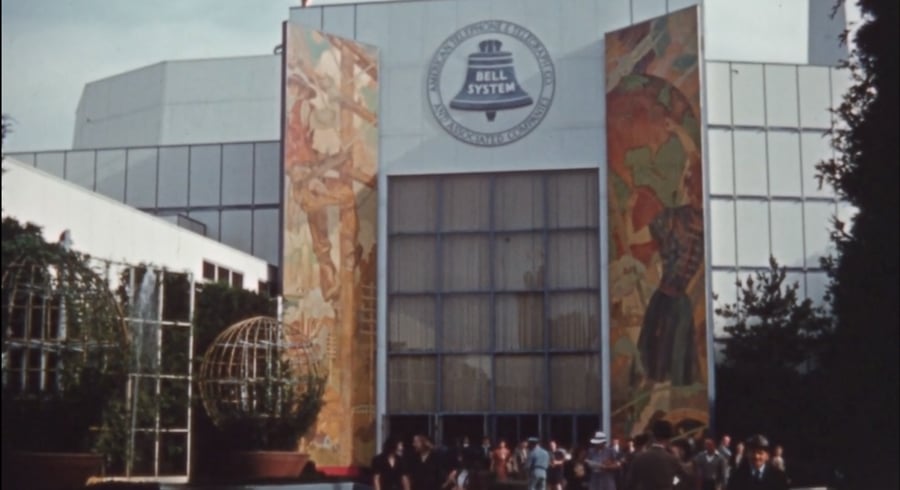
February 7, 2018
Filmmaker Rick Prelinger Is Resurrecting New York City’s Lost Urban Landscapes
Prelinger’s film, Lost Landscapes of New York, uses rarely-seen period footage to reveal the city’s daily life and changing streetscape.
Lost Landscapes of NY: Director’s Cut: 1939 NY World’s Fair Telephone Pavilion and TV Demonstration
Rick Prelinger, a San Francisco–based filmmaker and professor of film and digital media at the University of California Santa Cruz, has a unique perspective on the life and growth of American cities since the 1920’s.
A drop-out from Berkeley whose first job in the film industry was research director for the 1988 documentary Heavy Petting, which is a humorous look at teenage romance in America, Prelinger began his “Lost Landscapes” participatory urban history project in 2006.
Long a collector of both black and white and color home movies made from the 1920’s to the late 1980’s, industrial films made from 1914 through the mid-1980’s, and footage shot by movie studios from the 1930’s to the 1960’s to serve as the background for commercially-released films, Prelinger edits and splices together hundreds of his movies together to create new documentary films. Ranging in length from 70 to 95 minutes, these documentaries focus on life in major U.S. cities, including San Francisco, Oakland, Los Angeles, Detroit and New York. When he screens them—something he has been doing worldwide since 2008—he encourages audience members to speak out as they watch them, asking questions or commenting about what they’re seeing.
Prelinger premiered his new New York film, Lost Landscapes of New York at New York University last November, and will screen it again this weekend at the Museum of the Moving Image in Queens, along with his Yesterday and Tomorrow in Detroit, made in 2015, and four industrial films dating from 1935 to 1958.
Lost Landscapes of NY: Director’s Cut: Third Avenue El before Demolition, 1955
His New York film spans much of the twentieth century in this city, covering daily life, social change, and the city’s evolving streetscapes; almost all footage had never been shown publicly before Prelinger made this documentary. Among the cityscapes, events, and individuals depicted in it are the streets and people of the Lower East Side, Harlem, Williamsburg, and Queens; Coney Island crowds in the 1920’s; Italian-Americans in Brooklyn in the 1930’s; a 1930’s train ride from the Bronx to Grand Central Station; elevated trains in the 1920’s and 1930’s; a visit to the original Penn Station before it was demolished; Manhattan neon signage; Spanish Harlem in the 1960’s; Depression-era “Hoovervilles”; 1930’s garment worker strikes; housing shortage and civil rights protests in Harlem in the 1940’s; and visits to both the 1939–40 and 1964–65 World’s Fairs.
Prelinger believes the original movies he repurposes into his own films create “great records of the cityscape, which is the intersection of individual buildings, streets, the infrastructure, people navigating them.”
Lost Landscapes of NY: Director’s Cut: Downtown and Lower East Side
Pointing to 1950’s footage in his New York film of the long-gone Third Avenue El, or elevated train, Prelinger suggested New York faces the same issues today as it did in the 1950’s, including a lack of investment in the city’s infrastructure; a lack of affordable housing; and aggressive police tactics.
New York, he adds, “is everything, it exemplifies everything about the future of urbanism. Everything in New York is larger than life, so much needs to be fixed, finance and capital have such a huge influence. These films can inspire ideas into the public discourse.”
Prelinger’s latest project holds great promise for those intrigued by urban life and its challenges and pleasures: He is working on a film that will juxtapose theories of major 20th century American urbanists such as Lewis Mumford, Jane Jacobs, and William H. Whyte with home movies depicting what he calls the “lived experience in the city.”
He said the film—which he hopes to release next year—will pitch the “popular versus the elite,” asking viewers whether they should trust “images made by ordinary people or words of the elites.”
“I’m not into nostalgia, I do believe we should look critically at the past,” he concluded.
Lost Landscapes of Los Angeles: Suburb and Beany’s Drive-In, Long Beach
For more details on Prelinger’s screenings at the Museum of the Moving Image on February 10th and 11th, click here.
You may also enjoy “VIDEO: Why the AT&T Building Matters.”





